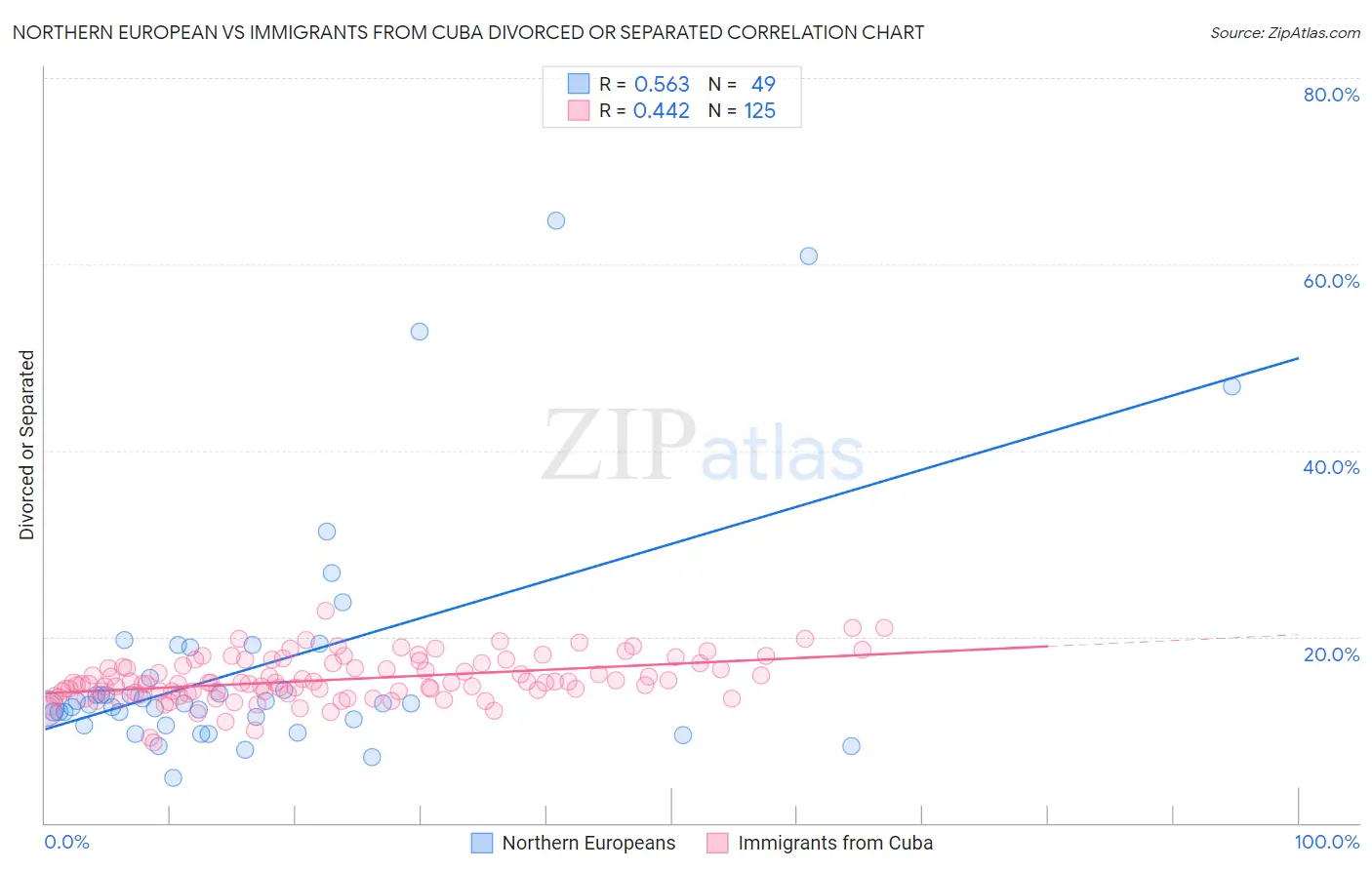Northern European vs Immigrants from Cuba Divorced or Separated
COMPARE
Northern European
Immigrants from Cuba
Divorced or Separated
Divorced or Separated Comparison
Northern Europeans
Immigrants from Cuba
12.2%
DIVORCED OR SEPARATED
14.7/ 100
METRIC RATING
217th/ 347
METRIC RANK
15.2%
DIVORCED OR SEPARATED
0.0/ 100
METRIC RATING
347th/ 347
METRIC RANK
Northern European vs Immigrants from Cuba Divorced or Separated Correlation Chart
The statistical analysis conducted on geographies consisting of 405,985,696 people shows a substantial positive correlation between the proportion of Northern Europeans and percentage of population currently divorced or separated in the United States with a correlation coefficient (R) of 0.563 and weighted average of 12.2%. Similarly, the statistical analysis conducted on geographies consisting of 325,985,435 people shows a moderate positive correlation between the proportion of Immigrants from Cuba and percentage of population currently divorced or separated in the United States with a correlation coefficient (R) of 0.442 and weighted average of 15.2%, a difference of 24.4%.

Divorced or Separated Correlation Summary
| Measurement | Northern European | Immigrants from Cuba |
| Minimum | 4.9% | 8.7% |
| Maximum | 64.7% | 22.8% |
| Range | 59.8% | 14.1% |
| Mean | 16.9% | 15.4% |
| Median | 12.8% | 15.0% |
| Interquartile 25% (IQ1) | 10.8% | 14.0% |
| Interquartile 75% (IQ3) | 17.2% | 17.2% |
| Interquartile Range (IQR) | 6.4% | 3.2% |
| Standard Deviation (Sample) | 12.9% | 2.4% |
| Standard Deviation (Population) | 12.8% | 2.4% |
Similar Demographics by Divorced or Separated
Demographics Similar to Northern Europeans by Divorced or Separated
In terms of divorced or separated, the demographic groups most similar to Northern Europeans are Immigrants from South America (12.2%, a difference of 0.040%), Immigrants from Argentina (12.2%, a difference of 0.050%), European (12.2%, a difference of 0.050%), Immigrants from Eastern Africa (12.2%, a difference of 0.10%), and Slovene (12.3%, a difference of 0.11%).
| Demographics | Rating | Rank | Divorced or Separated |
| Slavs | 17.0 /100 | #210 | Poor 12.2% |
| Trinidadians and Tobagonians | 16.6 /100 | #211 | Poor 12.2% |
| Immigrants | Kenya | 16.5 /100 | #212 | Poor 12.2% |
| Immigrants | Eastern Africa | 16.2 /100 | #213 | Poor 12.2% |
| Immigrants | Argentina | 15.5 /100 | #214 | Poor 12.2% |
| Europeans | 15.4 /100 | #215 | Poor 12.2% |
| Immigrants | South America | 15.4 /100 | #216 | Poor 12.2% |
| Northern Europeans | 14.7 /100 | #217 | Poor 12.2% |
| Slovenes | 13.2 /100 | #218 | Poor 12.3% |
| Czechoslovakians | 11.7 /100 | #219 | Poor 12.3% |
| British | 11.6 /100 | #220 | Poor 12.3% |
| Guamanians/Chamorros | 11.3 /100 | #221 | Poor 12.3% |
| Bangladeshis | 10.5 /100 | #222 | Poor 12.3% |
| Scandinavians | 10.4 /100 | #223 | Poor 12.3% |
| Immigrants | Azores | 9.7 /100 | #224 | Tragic 12.3% |
Demographics Similar to Immigrants from Cuba by Divorced or Separated
In terms of divorced or separated, the demographic groups most similar to Immigrants from Cuba are Arapaho (14.8%, a difference of 2.8%), Kiowa (14.5%, a difference of 4.9%), Cuban (14.5%, a difference of 5.0%), Creek (14.4%, a difference of 5.7%), and Seminole (14.3%, a difference of 6.8%).
| Demographics | Rating | Rank | Divorced or Separated |
| Puerto Ricans | 0.0 /100 | #333 | Tragic 13.9% |
| Immigrants | Bahamas | 0.0 /100 | #334 | Tragic 13.9% |
| Dutch West Indians | 0.0 /100 | #335 | Tragic 14.0% |
| Shoshone | 0.0 /100 | #336 | Tragic 14.0% |
| Crow | 0.0 /100 | #337 | Tragic 14.1% |
| Choctaw | 0.0 /100 | #338 | Tragic 14.1% |
| Colville | 0.0 /100 | #339 | Tragic 14.2% |
| Chickasaw | 0.0 /100 | #340 | Tragic 14.2% |
| Bahamians | 0.0 /100 | #341 | Tragic 14.2% |
| Seminole | 0.0 /100 | #342 | Tragic 14.3% |
| Creek | 0.0 /100 | #343 | Tragic 14.4% |
| Cubans | 0.0 /100 | #344 | Tragic 14.5% |
| Kiowa | 0.0 /100 | #345 | Tragic 14.5% |
| Arapaho | 0.0 /100 | #346 | Tragic 14.8% |
| Immigrants | Cuba | 0.0 /100 | #347 | Tragic 15.2% |